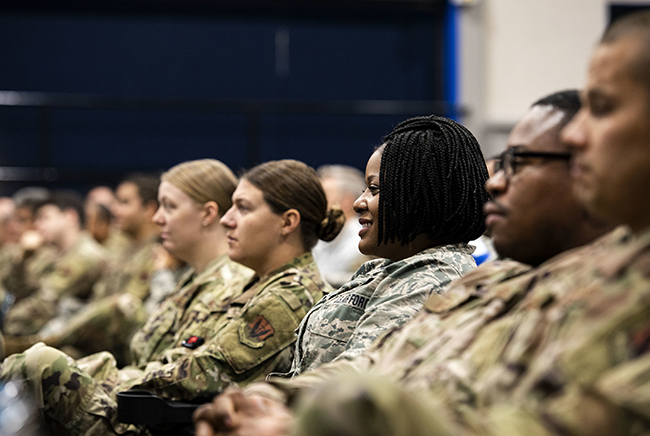
Airmen assigned to the 23rd Wing attend a commander’s call Sept. 30, 2019, at Moody AFB, Ga. Air Force photo by SrA. Erick Requadt.
The Air Force met its recruitment and end-strength goals for fiscal 2019, but Active Duty retention successes are partially driving fewer service members to join the Reserve.
The Air Force added 4,700 Total Force airmen in 2019 to reach 506,200 uniformed members, while competing for pilots and people in other professions in hot commercial markets with low unemployment. As the service convinces people to stay on Active Duty, though, the pool of prospective Reservists shrinks.
An Air Force Reserve Command spokesman told Air Force Magazine that prior service members made up 59 percent of accessions in fiscal 2019. That’s slightly lower than the average in the last five years, when 64 percent of new Reservists previously served.
“Some of the change in our [prior service] accessions percentage can be attributed to changes in [regular Air Force] retention,” AFRC spokesman Tyler Grimes said. “However, some of that change is due to some adjustments with the Palace Chase and Palace Front waiver process.”
Palace Chase personnel choose to finish their Active Duty commitment in the Reserve and must get approval from the Air Force Personnel Center. Palace Front personnel elect to join the Reserve after their Active Duty time is up.
Barbara Barrett, President Donald Trump’s nominee to be the next Air Force secretary, raised the issue in written testimony submitted to lawmakers in September. The Air Force is offering larger retention bonuses and extending the maximum number of years enlisted airmen can serve before mandatory separation or retirement, she wrote.
The challenges of personnel crossflows won’t go away soon. The Air Force wants to add another 4,300 Active Duty members and 100 Reserve members in fiscal 2020. The Air National Guard was on track to exceed its end-strength goal for 2019 and wants to add around 500 more in 2020, ANG Director Lt. Gen. L. Scott Rice told reporters Sept. 18.
Barrett said the Air Force must focus on more than raw numbers. “Although much is made of end strength as a metric, the quality of our officers and enlisted airmen more closely defines the need,” she wrote. “Maintaining high standards is essential to attracting, building, and retaining a lethal force.” She also intends to address work-life balance and family needs to keep more people in the force.
To do that, Barrett said she could turn to “big data” analytics to better identify candidates with the right qualifications to enlist. “Recruiting and screening standards are core to the character of the force,” she said. The Air Force may need to rethink medical and other qualifications, and consider how to use “waivers and adjustments” to take in particularly promising candidates.
Higher pay is also not a silver bullet, she said. “Many of today’s youth are not focused only on compensation,” Barrett said. “Instead they calculate their total reward, fulfillment from the job, and the quality of the life they choose. The Air Force and Space Force offer young people jobs that inspire.”
Rice said the ANG is retaining more than 95 percent of its airmen and plans to boost its support staff, like those assisting commanders and the inspector general, as well as health professionals.
He believes the Guard’s business model can help the Air Force grow its force more quickly, especially as it looks to increase its number of fighter squadrons. ANG’s “one-third full-time, two-thirds traditional part-time mix is a half to a third of what an Active Duty squadron would cost,” Rice said.